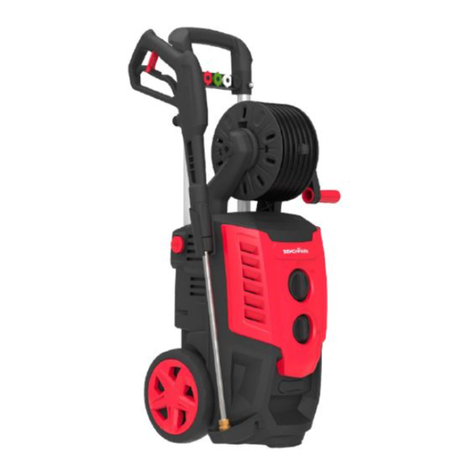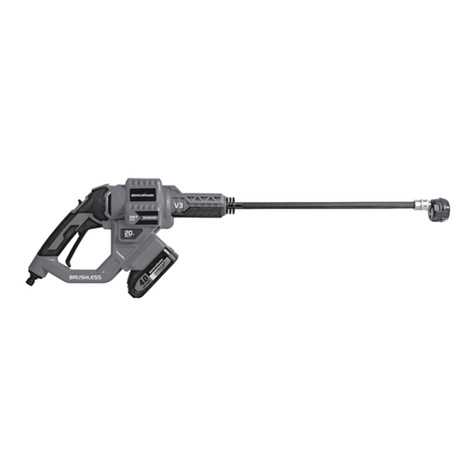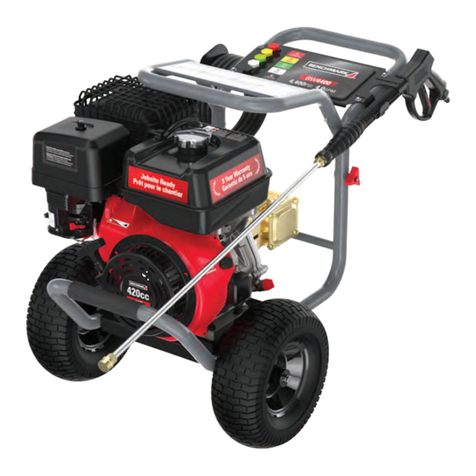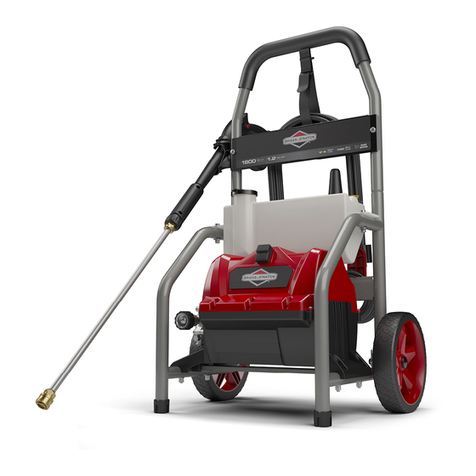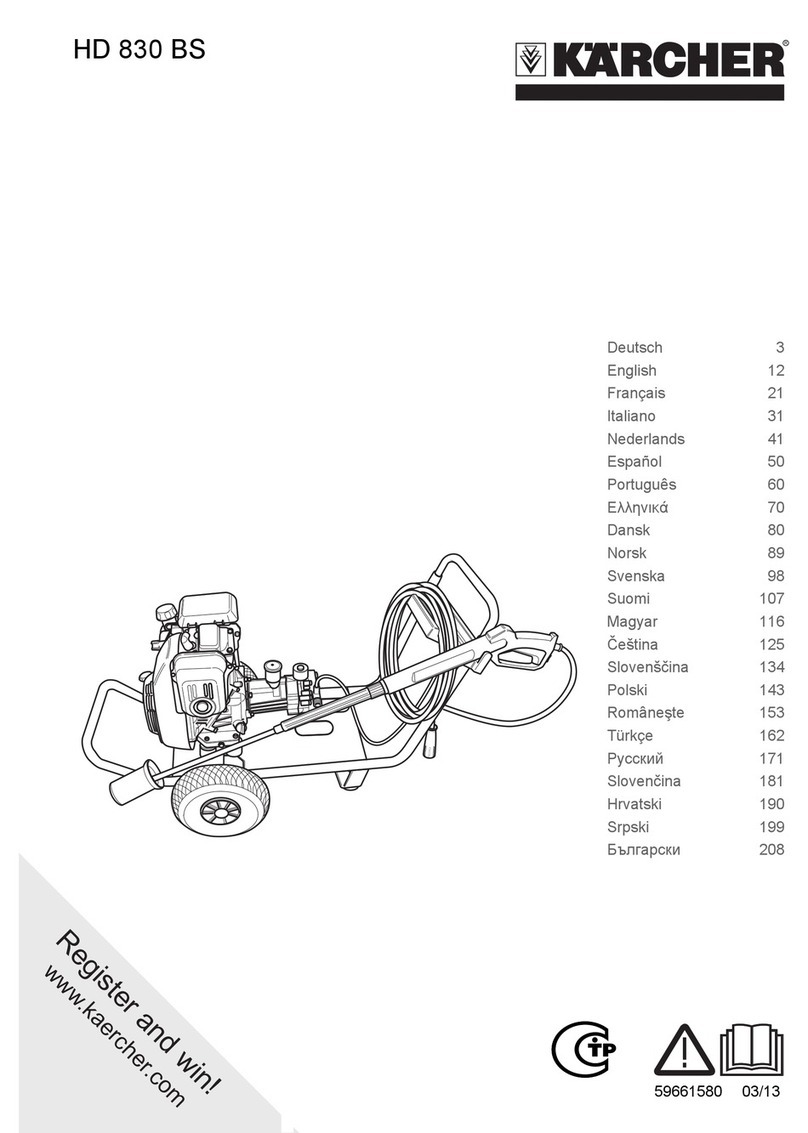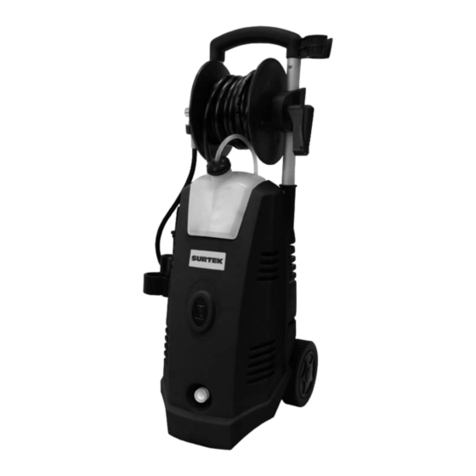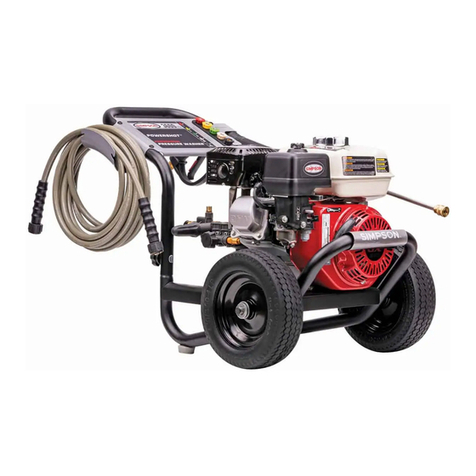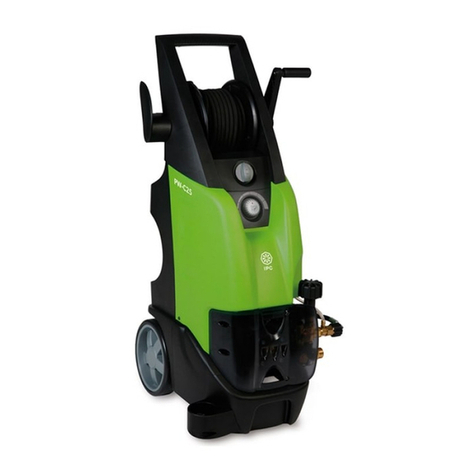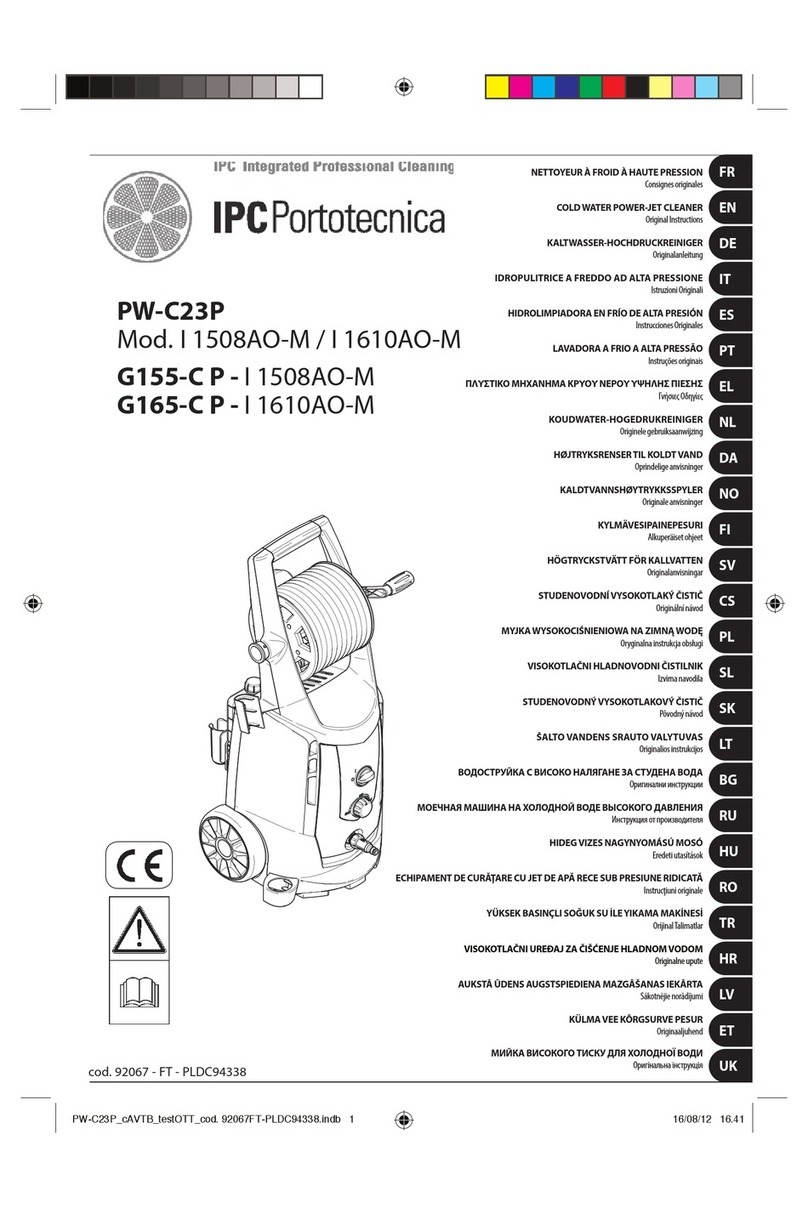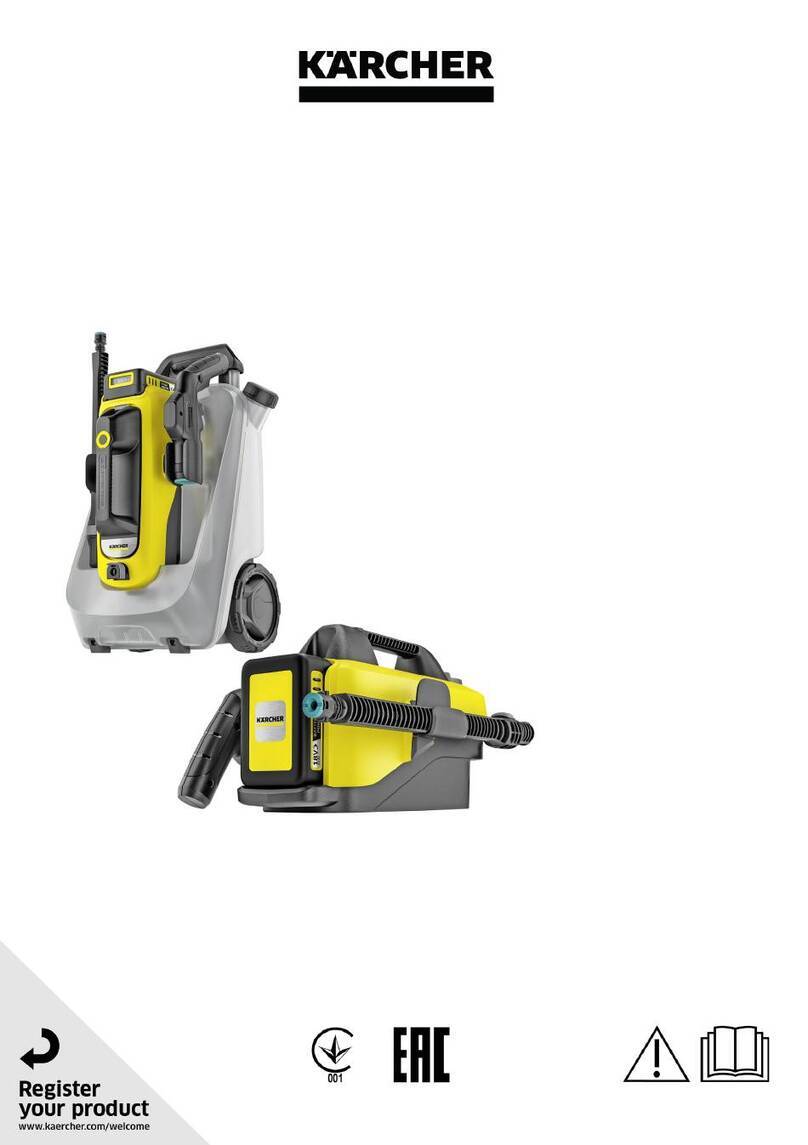Benchmark 209CC User manual

5049-744
YOU WILL NEED THIS MANUAL FOR SAFETY INSTRUCTIONS,
OPERATING PROCEDURES, AND WARRANTY. THE ORIGINAL
SALES RECEIPT IS REQUIRED FOR WARRANTY SERVICE.
SAVE THIS MANUAL
FOR REFERENCE
OWNER'S MANUAL
209CC PRESSURE WASHER, 3200 PSI

1
209CC PRESSURE WASHER, 3200 PSI
OWNER'S MANUAL
PRODUCT SPECIFICATIONS
Max. outlet pressure: 3200 PSI*
Max flow rate: 2.5 GPM
Water SupplyTemperature: Not to exceed 100°F (38°C)
Engine: OHV, 4-stroke
Displacement: 209 cc
Spark plug type: CHAMPION RC12YC
Oil capacity: Max. 20 Ounces (Max. 600 ml)
PRESSURE WASHER SPECIFICATIONS
ENGINE SPECIFICATIONS

2
5049-744
TABLE OF CONTENTS
Product specifications
Table of contents
Safety rules
Features and controls
Assembly
Operation
Maintenance
Storage
Troubleshooting
Exploded view
Parts list
Warranty
………………………………………………………1
………………………………………………………2
………………………………………………………3-9
………………………………………………………10
………………………………………………………11-17
………………………………………………………18-25
………………………………………………………26-34
………………………………………………………35-36
………………………………………………………37-38
………………………………………………………39-40
………………………………………………………41-45
………………………………………………………46

3
209CC PRESSURE WASHER, 3200 PSI
OWNER'S MANUAL
IMPORTANT SAFETY INFORMATION
Read this manual carefully and become familiar with your pressure washer. Know
its applications, its limitations, and any hazards involved.
SAFETY SYMBOLS AND MEANINGS
Operator's manual Toxic fumes Electrical shock Slippery surface Fall
Fluid Injection Fire Explosion Kickback Projectile
Moving parts Flying Objects Chemical burn Hot Surface
The safety alert symbol indicates a potential personal injury hazard. A signal word
(DANGER, WARNING, or CAUTION) is used with the alert symbol to designate
a degree or level of hazard seriousness. A safety symbol may be used to represent the
type of hazard. The signal word NOTICE is used to address practices not related to
personal injury.
DANGER indicates a hazard which, if not avoided, will result in death or serious
injury.
WARNING indicates a hazard which, if not avoided, could result in death or serious
injury.
CAUTION indicates a hazard which, if not avoided, could result in minor or moderate
injury.
NOTICE address practices not related to personal injury.
WARNINGThe engine exhaust from this product contains chemicals known to
the State of California to cause cancer, birth defects, or other reproductive harm.
WARNINGThis product contains lead and lead compounds, known to the State
of California to cause birth defects or other reproductive harm. Wash your hands
after handling this product.

4
5049-744
WARNING POISONOUS GAS HAZARD.
Engine exhaust contains carbon monoxide, a poisonous gas that could kill you
in minutes. You CANNOT smell it, see it, or taste it. Even if you do not smell
exhaust fumes, you could still be exposed to carbon monoxide gas. Some chemicals
or detergents could be harmful if inhaled or ingested, resulting in death, serious
injury, nausea, fainting or poisoning.
• Operate this product ONLY outside far away from windows, doors and vents to
reduce the risk of carbon monoxide gas from accumulating and potentially being
drawn towards occupied spaces.
• Install battery operated carbon monoxide alarms or plug-in carbon monoxide
alarms with battery backup according to the manufacturer's instructions. Smoke
alarms cannot detect carbon monoxide gas.
• DO NOT run this product inside homes, garages, basements, crawl spaces, sheds,
or other partially enclosed spaces even if using fans or opening doors and windows
for ventilation. Carbon monoxide can quickly build up in these spaces and can linger
for hours, even after this product has shut off.
• ALWAYS place this product downwind and point the engine exhaust away from
occupied spaces. If you start to feel sick, dizzy, or weak while using this product, shut
it off and get to fresh air RIGHT AWAY. See a doctor.You may have carbon monoxide
poisoning.
• Use a respirator or mask whenever there is a chance that vapors may be inhaled
when using chemicals.
• Read all instructions with mask so you are certain the mask will provide the necessary
protection against inhaling harmful vapors when using chemicals.
WARNING Chemical Burn Hazard.
Chemicals could cause burns resulting in death or serious injury.
• DO NOT use caustic liquid with pressure washer.
• Use ONLY pressure washer safe detergents/soaps. Follow all manufacturers
instructions.
WARNING
• Read all the instructions before using the product.
• To reduce the risk of injury, close supervision is necessary when a product is used
near children.
• Know how to stop the product and bleed pressures quickly. Be thoroughly familiar
with the controls.
• Stay alert – watch what you are doing.

5
209CC PRESSURE WASHER, 3200 PSI
OWNER'S MANUAL
• Do not operate the product when fatigued or under the influence of alcohol or drugs.
• Keep operating area clear of all persons
• Do not overreach or stand on unstable support. Keep good footing and balance at
all times.
• Follow the maintenance instructions specified in the manual.
WARNING Starter cord kickback (rapid retraction) will pull hand and arm
toward engine
faster than you can let go which could cause broken bones,
fractures, bruises,
or sprains resulting in serious injury.
• Never pull starter cord without first relieving spray gun pressure.
• When starting engine, pull cord slowly until resistance is felt and then pull rapidly
to avoid kickback.
• After each starting attempt, where engine fails to run, always point spray gun in
safe direction, press grey button and squeeze spray gun trigger to release high
pressure.
• Firmly grasp spray gun with both hands when using high pressure spray to avoid
injury when spray gun kicks back.
WARNING Risk of electrocution
Contact with power source could cause electric shock or burn resulting in
death or serious injury or sprains resulting in serious injury.
• NEVER spray near power source.
WARNING
The high pressure stream of water that this equipment produces
could cut
through skin and its underlying tissues, resulting in serious injury and
possible amputation.
Spray gun traps high water pressure, even when engine is stopped and water is
disconnected, which could result in serious injury.
• If cut by fluid, call physician immediately. DO NOT treat as a simple cut.
• DO NOT allow CHILDREN to operate pressure washer.
• NEVER repair high pressure hose. Replace it.
• NEVER repair leaking connections with sealant of any kind. Replace O-ring or seal.
• NEVER connect high pressure hose to nozzle extension.
• Keep high pressure hose connected to pump and spray gun while system is pressurized.
• ALWAYS point spray gun in safe direction, press grey button and squeeze spray
gun trigger to release high pressure, every time you stop engine.
• NEVER aim spray gun at people, animals, or plants.

6
5049-744
• DO NOT secure spray gun in open position.
• DO NOT leave spray gun unattended while machine is running.
• NEVER use a spray gun which does not have a trigger lock or trigger guard in place
and in working order.
• Always be certain spray gun, nozzles and accessories are correctly attached.
WARNING Fuel and its vapors are extremely flammable and explosive
which could cause burns, fire or explosion resulting in death or serious
injury.
WHEN ADDING OR DRAINING FUEL
• Turn pressure washer engine OFF and let it cool at least 2 minutes before removing
fuel cap. Loosen cap slowly to relieve pressure in tank.
• Fill or drain fuel tank outdoors.
• DO NOT overfill tank. Allow space for fuel expansion.
• If fuel spills, wait until it evaporates before starting engine.
• Keep fuel away from sparks, open flames, pilot lights, heat, and other ignition
sources.
• Check fuel lines, tank, cap and fitting frequently for cracks or leaks. Replace if
necessary.
• DO NOT light a cigarette or smoke.
WHEN STARTING EQUIPMENT
• Ensure spark plug, muffler, fuel cap, and air cleaner are in place.
• DO NOT crank engine with spark plug removed.
WHEN OPERATING EQUIPMENT
• DO NOT operate this product inside any building, carport, porch, mobile equipment,
marine applications, or enclosure.
• DO NOT tip engine or equipment at angle which causes fuel to spill.
• DO NOT spray flammable liquids.
WHEN TRANSPORTING, MOVING OR REPAIRING EQUIPMENT
•Transport/move/repair with fuel tank EMPTY.
• DO NOT tip engine or equipment at angle which causes fuel to spill.
• Disconnect spark plug wire.
WHEN STORING FUEL OR EQUIPMENT WITH FUEL IN TANK
• Store away from furnaces, stoves, water heaters, clothes dryers, or other appliances
that have pilot light or other ignition source because they could ignite fuel vapors.

7
209CC PRESSURE WASHER, 3200 PSI
OWNER'S MANUAL
WARNING
• If you do not follow these instructions exactly, a fire or explosion may result causing
property damage, personal injury or loss of life.
• In the event of pilot outage, wait at least five minutes to clear out any gas before
relighting.
• Use only your hand to push in or turn the gas control knob. Never use a tool. If the
knob will not push in or turn by hand, don't try to repair it; call a qualified service
technician.
WARNING
Exhaust heat/gases could ignite combustibles, structures
or damage fuel tank causing a fire, resulting in death or serious injury.
Contact with muffler area could cause burns resulting in serious injury.
• DO NOT touch hot parts and AVOID hot exhaust gases.
• Allow equipment to cool before touching.
• Keep at least 5 ft. (1.5 m) of clearance on all sides of pressure washer including
overhead.
It is a violation of California Public Resource Code, Section 4442, to use or operate
the engine on any forest covered, brush-covered, or grass-covered land unless the
exhaust system is equipped with a spark arrester, as defined in Section 4442, maintained
in effective working order. Other states or federal jurisdictions may have similar
laws. Contact the original equipment manufacturer, retailer, or dealer to obtain a
spark arrester designed for the exhaust system installed on this engine.
• Replacement parts must be the same and installed in the same position as the
original parts.
WARNING Use of pressure washer could create puddles and slippery
surfaces causing you to fall resulting in death or serious injury.
Kickback from spray gun could cause you to fall resulting in death or
serious injury.
• Operate pressure washer from a stable surface.
•The cleaning area should have adequate slopes and drainage to reduce the possibility
of a fall due to slippery surfaces.
• Be extremely careful if you must use the pressure washer from a ladder, scaffolding,
or any other similar location.
• Firmly grasp spray gun with both hands when using high pressure spray to avoid
injury when spray gun kicks back.
WARNING Unintentional sparking could cause fire or electric shock
resulting in death or serious injury.

8
5049-744
WHEN ADJUSTING OR MAKING REPAIRS TO YOUR PRESSURE WASHER
• Disconnect the spark plug wire from the spark plug and place the wire where it
cannot contact spark plug.
WHEN TESTING FOR ENGINE SPARK
• Use approved spark plug tester.
• DO NOT check for spark with spark plug removed.
WARNING Starter and other rotating parts could entangle hands, hair, clothing,
or accessories resulting in serious injury.
• NEVER operate pressure washer without protective housing or covers.
• DO NOT wear loose clothing, jewelry or anything that could be caught in the starter
or other rotating parts.
•Tie up long hair and remove jewelry.
WARNING Risk of eye or bodily injury. Spray could splash back or
propel objects resulting in serious injury.
• Always wear indirect vented (chemical splash) safety goggles marked
to comply with ANSI Z87.1 when using or in vicinity of this equipment.
• NEVER substitute safety glasses or dry condition goggles for indirect vented safety
goggles.
• Always wear protective clothing such as a long sleeved shirt, long pants and
close-toed shoes.
• NEVER operate pressure washer when barefoot or wearing sandals or shorts.
CAUTION Excessively high operating speeds could result in minor injury.
Excessively low speeds impose a heavy load.
• DO NOT tamper with governor spring, links or other parts to increase engine
speed. Pressure washer supplies correct rated pressure and flow when running at
governed speed.
• DO NOT modify pressure washer in any way.
NOTICE High pressure spray could damage fragile items including glass.
• DO NOT point spray gun at glass when using red (0 °) spray tip.
• NEVER aim spray gun at plants.
NOTICE Improper treatment of pressure washer could damage it and shorten its life.
• If you have questions about intended use, ask dealer or contact qualified service center.
• NEVER operate units with broken or missing parts, or without protective housing or covers.
•
DO NOT bypass any safety device on this machine.

9
209CC PRESSURE WASHER, 3200 PSI
OWNER'S MANUAL
• DO NOT tamper with governed speed.
• DO NOT operate pressure washer above rated pressure.
• DO NOT modify pressure washer in any way.
• Before starting pressure washer in cold weather, check all parts of the equipment to
be sure ice has not formed there.
• NEVER move machine by pulling on hoses. Use handle provided on unit.
Use only identical replacement parts as specified in the parts list in this manual. User
assumes all risks and liabilities if other parts are used.

10
5049-744
FEATURES AND CONTROLS
KNOW YOUR PRESSURE WASHER
Read the operator's manual and safety rules before operating your pressure washer.
Compare the illustrations with your pressure washer to familiarize yourself with
the locations of various controls and adjustments. Save this manual for future reference.
A - Quick-Connect Nozzles - 15°, 40° for high pressure, soap is for detergent function with low
pressure water steam.Turbo is for rotating flush.
B - Nozzle Needle - Clean the nozzles.
C - Spray Gun - Controls the application of water onto cleaning surface with trigger device. In-
cludes trigger lock.
D - Water Inlet - Connection for garden hose.
E - Spray Wand - Attach to spray gun to use four different quick-connect nozzles.
F - Air Filter - Protects engine by filtering dust and debris out of intake air.
G - Choke Lever - Used to help start a cold engine.
H - Fuel Valve Lever - Set the fuel supply valve.
I - Detergent Tank - Use to store detergent for the low pressure water stream.
J - Recoil Starter - Used for starting the engine manually.
K - Engine Switch - Set the engine in starting mode and stop a running engine.
L - Oil Fill Cap/ Dipstick - Check, fill and drain engine oil here.
M - Pump - Develops high pressure water.
N - Fuel Tank Cap - Fill engine with regular unleaded fuel here. Always leave room for fuel expansion.
O - High Pressure Hose - Connect one end to the spray gun, the other end to the pump (already
assembled to the pump at the factory).

11
209CC PRESSURE WASHER, 3200 PSI
OWNER'S MANUAL
ASSEMBLY
Your pressure washer requires some assembly and is ready for use only after it has
been properly serviced with the recommended oil and fuel.
If you have any problems with the assembly of your pressure washer, please
call the pressure washer help line at 1-833-818-4111.
IMPORTANT: Any attempt to run the engine before it has been serviced with the
recommended oil will result in an engine failure.
UNPACK THE PRESSURE WASHER
• Remove everything from carton except the pressure washer.
• Open carton completely by cutting each corner from top to bottom.
• Remove pressure washer from carton.
CARTON CONTENTS
Check all contents. If any parts are parts are missing or damaged, call the pressure
washer helpline at 1-833-818-4111.
A - Main unit G - Operator's manual
B - Quick-connect nozzles (4) H - Hand crank
C - Nozzle needle I - Funnel
D - High pressure hose J - Oil bottle
E - Spray gun K- Detergent tank
F - Spray wand

12
5049-744
Become familiar with each piece before assembling the pressure washer. Check all
contents against the illustration. If any parts are missing or damaged, call the pressure
washer helpline at 1-833-818-4111.
ASSEMBLING YOUR PRESSURE WASHER
Your high pressure washer was mostly assembled at the factory. However, you will
need to perform these tasks before you can operate your pressure washer:
1. Handle position adjustment. 5. Lubricate O-rings.
2. Connect hand crank onto hose reel. 6. Connect hose and water supply to pump.
3. Add oil to engine crankcase. 7. Connect spray wand and quick-connect nozzles.
4. Add fuel to fuel tank. 8. Connect hose to the spray gun.
1. HANDLE POSITION ADJUSTMENT
Turn the handle 2 upward around 100°, until the locking/releasing pin 1 engages into
the corresponding hole on the frame. Make sure the handle was fixed securely before
each use.
To fold the handle, pull the locking/releasing
pin 1 outward on the right side of the pressure
washer, and turn the handle 2 downward to
fold the handle.
2. CONNECT HAND CRANK ONTO
HOSE REEL
Attach hand crank onto the hose reel. Insert in
the hole and snap into place by hand. No tools
required.
1
2
Pull
Unfold Fold
Pull

13
209CC PRESSURE WASHER, 3200 PSI
OWNER'S MANUAL
WARNING! Fuel and its vapors are extremely flammable and explosive
which could cause burns, fire or explosion resulting in death or serious
injury.
WHEN ADDING FUEL
•Turn pressure washer engine OFF and let it cool at least 2 minutes before removing
fuel cap.
Loosen cap slowly to relieve pressure in tank.
• Fill fuel tank outdoors.
• DO NOT overfill tank. Allow space for fuel expansion.
• If fuel spills, wipe it out before starting engine.
• Keep fuel away from sparks, open flames, pilot lights, heat, and other ignition sources.
• Check fuel lines, tank, cap and fittings frequently for cracks or leaks. Replace if necessary.
• DO NOT light a cigarette or smoke.
3. CHECK OIL LEVEL
Before adding or checking the oil:
• Make sure the engine is level.
• Clean the oil fill area of any debris.
1. Remove the dipstick and wipe with
a clean cloth.
2. Install the dipstick. Do not turn or
tighten.
3. Remove the dipstick and check the
oil level. Correct oil level is at the top
of the full indicator on the dipstick.
4. If oil level is low, slowly add oil
into the engine oil fuel. Fill to point of overflowing.
5. Reinstall and tighten the dipstick.
NOTICE: Pause to permit oil to settle. Wipe dipstick clean each time oil level is checked.
DO NOT overfill.
4. ADD FUEL TO FUEL TANK
FUEL MUST MEET THESE REQUIREMENTS:
• Clean, fresh, unleaded gasoline.
• A minimum of 87 octane/ 87 AKI (91 RON). For high altitude use, see “High Altitude”.
• Gasoline with up to 10% ethanol (gasohol) is acceptable.
NOTICE: Use of unapproved fuels could damage the engine and voids warranty.
• DO NOT use unapproved gasoline such as E15 and E85.
• DO NOT mix oil in gasoline or modify engine to run on alternate fuels.
LH

14
5049-744
To protect the fuel system from gum formation, mix in a fuel stabilizer when adding
fuel. See “Storage”. All fuel is not the same. If you experience starting or performance
problems after using fuel, switch to a different fuel provider or change brands, This
engine is certified to operate on gasoline. The emission control system for the engine
is EM (Engine Modifications).
AB
1. Clean area around fuel fill cap, remove
cap.
2. Slowly add regular unleaded fuel (A)
to fuel tank (B). Be careful not to overfill.
To allow for fuel expansion, do not fill
above the bottom of the fuel tank neck.
3. Install fuel cap and wipe off the spilled
fuel.
CAUTION! Alcohol-blended fuels (called
gasohol, ethanol or methanol) can attract moisture, which leads to separation and for-
mation of acids during storage. Acidic gas can damage the fuel system of an engine
while in storage.
To avoid engine problems, the fuel system should be treated with fuel preserver or
emptied before storage of 30 days or longer. If adding a fuel preserver, fill the fuel tank
with fresh fuel. If only partially filled, air in the tank will promote fuel deterioration
during storage. If fuel preserver is not used, drain the fuel tank, start the engine and
let it run until the fuel lines and carburetor are empty. Use fresh fuel next season. See
“Storage” for additional information.
NEVER use engine or carburetor cleaner products in the fuel tank as permanent damage
may occur.
HIGH ALTITUDE
At altitude over 5,000 ft. (1524 m), a minimum 85 octane / 85 AKI (89 RON) gasoline
is acceptable. To remain emission compliant, high altitude adjustment is required.
Operation without this adjustment will cause decreased performance, increased fuel
consumption, and increased emissions. Operation of the engine at altitudes below
2,500ft (762m) with the high altitude kit is not recommended.
5.LUBRICATE O-RINGS
Lubrication of O-rings is extremely important for installation and operation. The use of
lubricant (petroleum or synthetic grease) during assembly helps seat O-rings properly and
provides and improved seal. It also helps protect the O-rings from damage by abrasion,
pinching or cutting and extends the life of the O-rings.
NOTICE: ALWAYS apply a small amount of lubricant on o-rings prior to assembling the
garden hose to the pump (C), high pressure hose (D), spray gun (E), and spray wand (F).
Lubricate all connections shown below, following these instructions:

15
209CC PRESSURE WASHER, 3200 PSI
OWNER'S MANUAL
1) Inspect and clean connecting
surfaces prior to lubrication and
assembly.
2) Use lubricants sparingly during
assembly; a light film is a all that
is required.
3) Use a small brush or cotton swab
to apply grease directly to O-rings
where they are not accessible (QC
fitting, M22 fitting).
6. CONNECT HOSE AND
WATER SUPPLY TO PUMP
IMPORTANT! DO NOT run the pump without
the water supply connected and turned on.
• Damage to pressure washer resulting from failure
to follow this instruction will void warranty.
NOTICE: Remove and discard the shipping caps
from the pump’s high pressure outlet and water
inlet before attaching hoses.
1) Uncoil high pressure hose when handle folded,
and attach one end of hose to the base of the
spray gun.Tighten by hand.The other end already
assembled to the pump at the factory.
NOTICE: The hose only can be uncoiled from
the bottom of the hose reel, it’s recommended to
keep the handle folded for easy unwinding and
winding the hose.
E
F
C
D
WARNING! The high pressure stream of water that the pressure washer
produces could cut through skin and its underlying tissues, resulting in serious
injury and possible amputation.
• NEVER connect high pressure hose to spray wand.
• Keep high pressure hose connected to pump and spray gun while system is
pressurized.
• Always be certain spray gun, wand, nozzles and other accessories are correctly
attached.
2) Before you connect your garden hose to the water inlet, inspect the inlet screen.
Clean the screen if it contains debris or have it replaced if damaged. Do Not run the
pressure washer if the inlet screen is damaged or missing.

16
5049-744
IMPORTANT! NEVER siphon standing
water for the water supply. Use only cold
water (less than 100 °F or 38°C).
CAUTION! Using a One Way Valve
(vacuum breaker or check valve) at
pump inlet could cause pump or inlet
connector damage.
1) There must be at least 10 ft. (3 m)
of unrestricted garden hose between
pressure washer inlet and any device,
such as a vacuum breaker or check
valve.
2) Damage to pressure washer resulting
from failure to follow these instructions
will void warranty.
3) Run water through garden hose for 30 seconds to flush it of debris.Turn off water.
4) Connect garden hose (not to exceed 50 ft. or 15 m. in length) to water inlet.Tighten
by hand.
WARNING! Risk of eye injury!
Spray could splash back or propel objects resulting in serious injury.
• Always wear indirect vented (chemical splash) safety goggles marked to
comply with ANSI Z87.1 when using or in vicinity of the pressure washer.
• NEVER substitute safety glasses or dry-condition goggles for indirect vented safety
goggles.
5) Turn ON the water, point the spray gun in a safe direction, release the grey
trigger lock, then squeeze trigger to purge the pump system of air and impurities.
Inspect inlet screen.
Do no use if damaged,
clean if dirty.

17
209CC PRESSURE WASHER, 3200 PSI
OWNER'S MANUAL
7. CONNECT SPRAY WAND AND QUICK-CONNECT NOZZLES
1) Attach the spray wand into spray gun.Tighten by hand.
2) Turn OFF the water and release trigger. Point the spray gun in a safe direction and
make sure trigger is locked and can’t be squeezed.
3) Choose the quick-connect nozzle you want to use, pull back on collar of spray wand,
insert the nozzle and release collar. Tug on the nozzle to make sure it is securely in
place. More information please see “How to Use Quick-Connect Nozzles” section.
15° 40° Soap Turbo
CHECK LIST BEFORE STARTING ENGINE
Review the assembly to ensure you have performed all of the following:
• Be sure to read "Safety Rules" and "Operation" sections before using the pressure
washer.
• Make sure handle is in place and secure.
• Check that oil has been added to proper level in engine crankcase.
• Add proper gasoline to fuel tank.
• Check for properly tightened hose connections (high pressure and water supply) and for
tight connections and that there are no kinks, cuts, or damage to the high pressure hose.
• Provide proper water supply (not to exceed 100°F or 38°C).
• If starting pressure washer after storage, see "Storage" section below.

18
5049-744
OPERATION
HOW TO USE YOUR PRESSURE WASHER
If you have any problems operating your pressure washer, please call the pressure
washer helpline at 1-833-818-4111.
PRESSURE WASHER LOCATION
CARBON MONOXIDE POISONING
WARNING! POISONOUS GAS HAZARD.
Engine exhaust contains carbon monoxide, a poisonous gas that could kill
you in minutes.
You CANNOT smell it, see it, or taste it, Even if you do not smell exhaust
fumes, you could still be exposed to carbon monoxide gas.
• Operate this product ONLY outside far away from windows, doors and vents to
reduce the risk of carbon monoxide gas from accumulating and potentially being
drawn towards occupied spaces.
• Install battery-operated carbon monoxide alarms or plug-in carbon monoxide
alarms with battery back-up according to the manufacturer's instructions. Smoke
alarms cannot detect carbon monoxide gas.
• DO NOT run this product inside homes, garages, basements, crawl spaces, sheds,
or other partially enclosed spaces even if using fans or opening doors and windows
for ventilation. Carbon monoxide can quickly build up in these spaces and can linger
for hours, even after this product has shut off.
• ALWAYS place this product downwind and point the engine exhaust away from
occupied spaces.
If you start to feel sick, dizzy, or weak
while using this product, shut it off
and get to fresh air RIGHT AWAY. See a
doctor.You may have carbon monoxide
poisoning.
Exhaust port pointed
away from occupied
spaces

19
209CC PRESSURE WASHER, 3200 PSI
OWNER'S MANUAL
RISK OF FIRE CLEARANCES
WARNING Exhaust heat/gases could ignite combustibles, structures or
damage fuel tank causing a fire, resulting in death or serious injury.
• Keep at least 5 ft. (1.5 m) clearance on all sides of pressure washer including
overhead.
TO START YOUR PRESSURE WASHER
To start your engine-powered pressure washer for the first time, follow these instructions
step-by-step. This starting information also applies whenever you start the engine after
you have let the pressure washer sit idle for at least a day.
1. Place pressure washer outside near a water source capable of supplying water at a
flow rate greater than 3.7 gallons per minute and no less than 20 PSI at pressure washer
end of garden hose.
2. Check that high pressure hose is tightly connected to spray gun and pump. See
“Assembly” for illustrations.
3. Make sure unit is in a level position.
4. Connect garden hose to water inlet on pressure washer pump.
CAUTION! Do Not run the pump without the water supply connected and turned on.
• Damage to pressure washer resulting from failure to follow this instruction will void
warranty.
5.Turn ON the water, point the spray gun at a safe direction, release the grey trigger
lock, then squeeze trigger to purge the pump system of air and impurities. See
"Assembly".
6. Attach the spray wand into spray gun.Tighten by hand. See "Assembly" .
7. Choose the quick-connect nozzle you want to
use, pull back on collar of spray wand, insert the
nozzle and release collar.Tug on the nozzle to make
sure it is securely in place. See "Assembly".
More
information please see “How to Use Quick-Connect
Nozzles” section
.
8. Engage the Grey trigger lock on the spray
gun.
9. Push engine rocker switch to ON position.
NOTICE: Before starting the pressure washer, be sure you are wearing safety goggles
as described below.
Off
On
WARNING! Risk of eye injury.
Spray could splash back or propel objects resulting in serious injury.
• Always wear indirect vented (chemical splash) safety goggles marked to
comply with ANSI Z87.1 when using or in vicinity of this equipment.
• NEVER substitute safety glasses or dry-condition goggles for indirect vented safety
goggles.
This manual suits for next models
1
Table of contents
Other Benchmark Pressure Washer manuals
